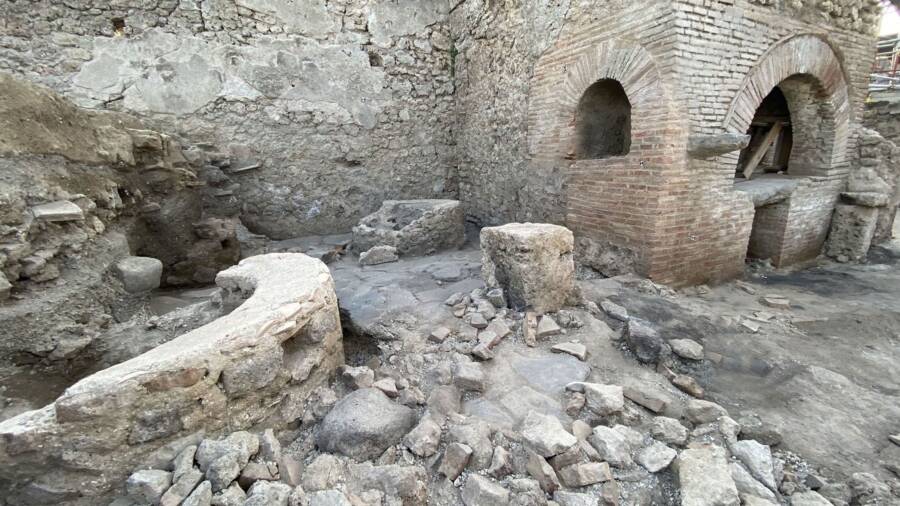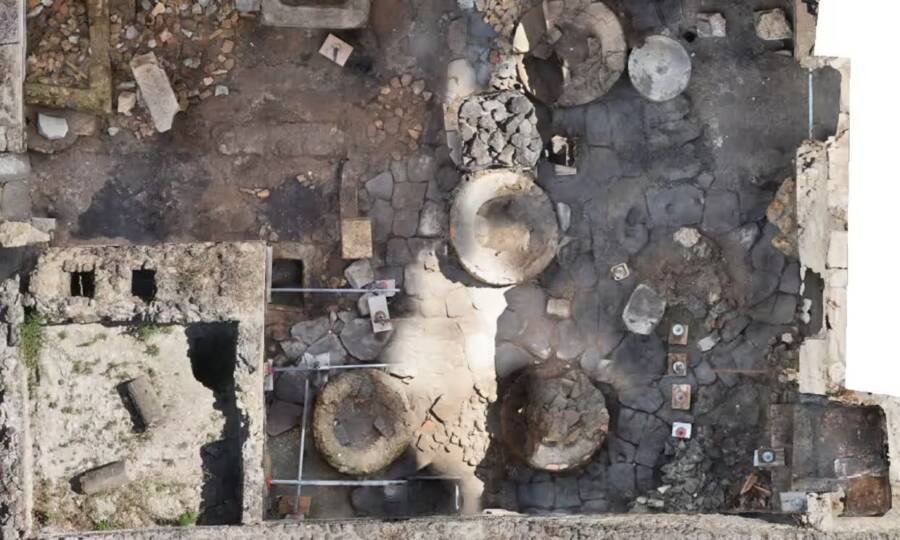Archaeologists also found the remains of three people inside the bakery — likely workers who weren't able to escape when Mount Vesuvius erupted in 79 C.E.

Archaeological Park of PompeiiThe “prison bakery” in Pompeii is just one of the latest archaeological discoveries in the doomed town.
There have been some astounding discoveries in Pompeii in recent years, including a ceremonial chariot, the ancient Roman version of a “fast food stand,” and erotic frescoes. But the latest discovery sheds light on an often overlooked part of Pompeii society: slavery.
Archaeologists excavating the doomed city, which was destroyed with the eruption of Mount Vesuvius in 79 C.E., recently announced the discovery of a “prison bakery” where humans and animals toiled under brutal conditions to make bread. According to a statement from the Archaeological Park of Pompeii, the cramped room had no view of the outside world and only a few high, barred windows. Indentations in the floor showed where blindfolded donkeys were forced to walk for hours in order to grind grain for bread.
There was no escape. The room had only one door, which led back into the atrium of a grand attached house filled with lavish frescoes.
“It is, in other words, a space in which we have to imagine the presence of people of servile status whose freedom of movement the owner felt the need to restrict,” Gabriel Zuchtriegel, the director of the Archaeological Park of Pompeii, explained in the statement. “It is the most shocking side of ancient slavery, the one devoid of both trusting relationships and promises of manumission, where we were reduced to brute violence, an impression that is entirely confirmed by the securing of the few windows with iron bars.”

Archaeological Park of PompeiiThe Pompeii prison bakery as seen from above.
Though the main home appeared to be undergoing renovations when Mount Vesuvius erupted, archaeologists discovered the bodies of three people in the bakery in recent months. According to the statement, this suggests that the property was not uninhabited during the catastrophic eruption.
For those people — and the animals who toiled beside them — everyday life would have been monotonous and brutal. Second-century author Apuleius described the conditions of such mills in The Golden Ass, according to The New York Times, in which he described enslaved people working in similar grain mills with “eyes so bleary from the scorching heat of that smoke-filled darkness they could barely see… like wrestlers sprinkled with dust before a fight, they were coarsely whitened with floury ash.”
The donkeys forced to work in the mill also suffered. “Their flanks were cut to the bone from relentless whipping,” Apuleius wrote, “their hoofs distorted to strange dimensions from the repetitive circling, and their whole hide blotched by mange and hollowed by starvation.”
The workers in the Pompeii mill worked around four tightly packed millstones, Zuchtriegel explained to The New York Times, where the constricted space called for a kind of “choreography.”
“The space was so small that two donkeys could not pass at the same time, so they always had to be careful to keep in some kind of synchrony with the others,” Zuchtriegel said.

Archaeological Park of PompeiiThe enslaved people and animals worked in a tight space with bars on the windows to prevent them from fleeing.
The New York Times also reports that the bakery was discovered during the excavation of the larger, attached house. There, archaeologists have made a number of fascinating discoveries, including a fresco that appears to depict pizza and a room filled with inscriptions for a politician named Aulus Rustius Verus, of whom the house’s owner was apparently an avid supporter.
Ultimately, the prison bakery paints a rather evocative picture of what life was like in Pompeii for some of its most downtrodden residents. Enslaved people made up a huge part of Pompeii’s population and propped up the area’s economy, but they’re often overlooked in historical accounts of the doomed city.
There’s no doubt what life was like for those who worked in the prison bakery, according to Zuchtriegel. As he told The New York Times, this most recent discovery paints “a very harsh and grim image” of their existence.
After reading about the “shocking” prison bakery unearthed in Pompeii, look through these powerful images of Pompeii victims frozen in time. Or, learn about the incredible restoration of Pompeii’s opulent House of the Vettii.





